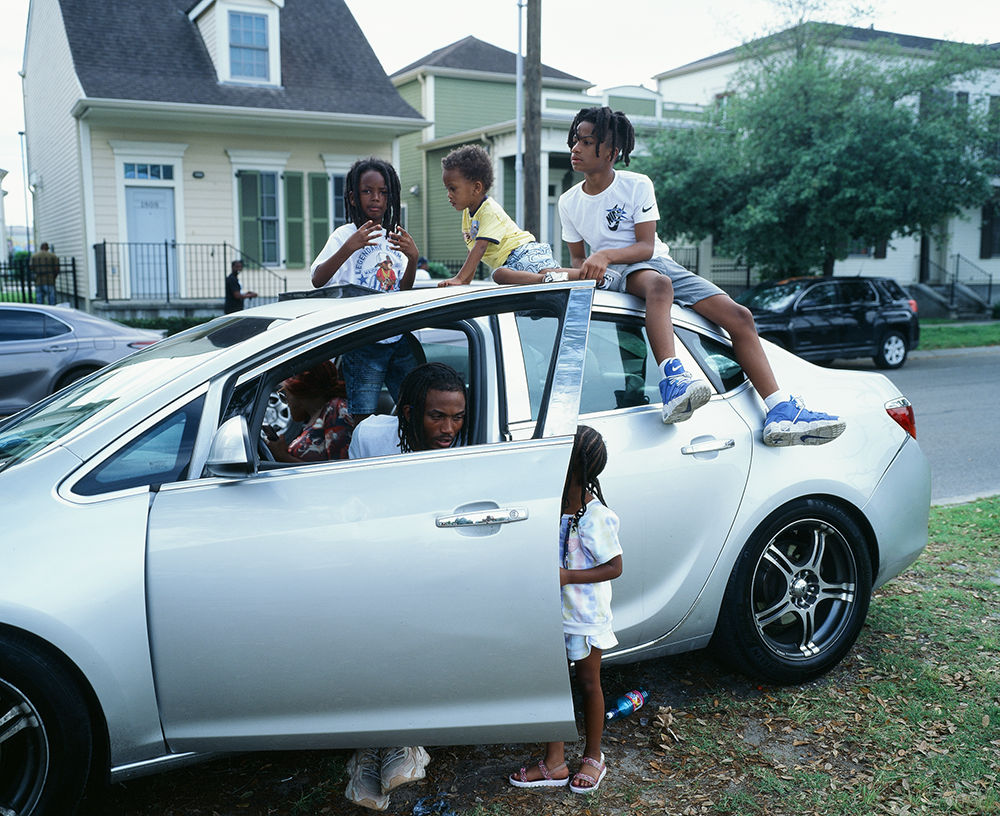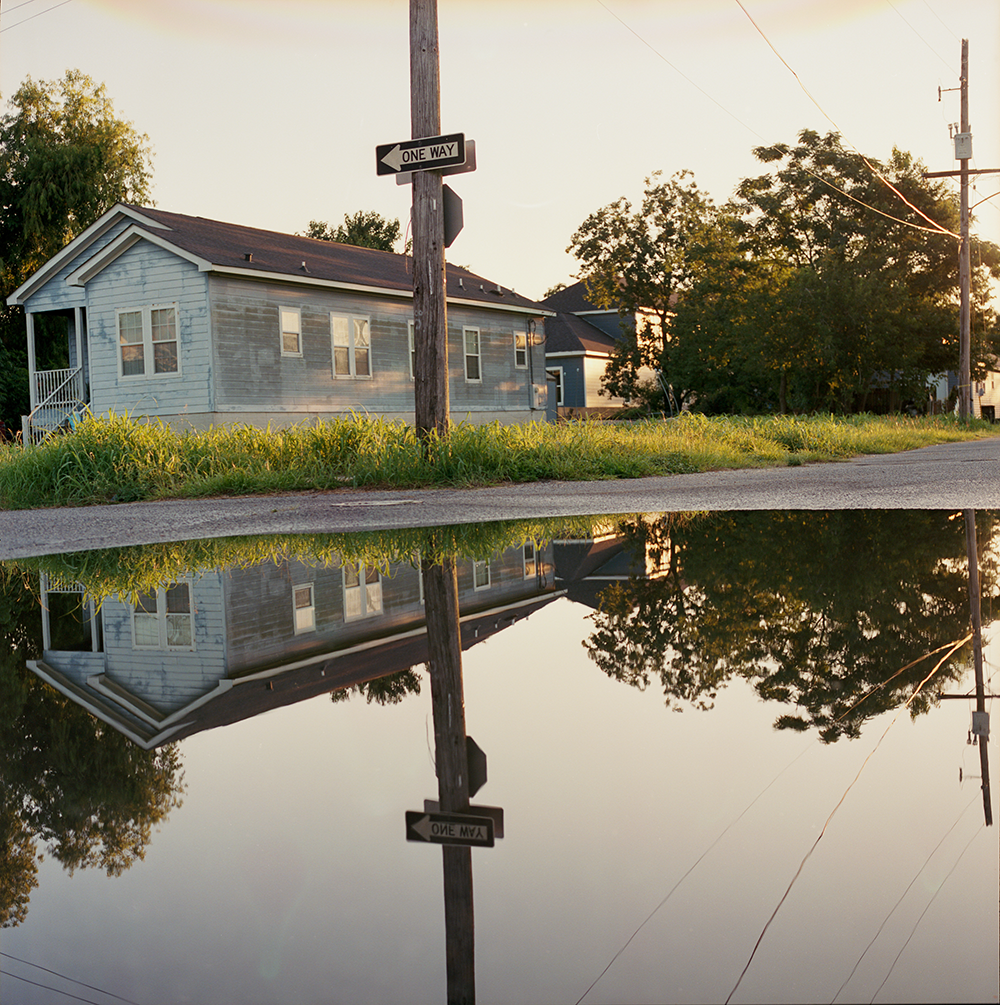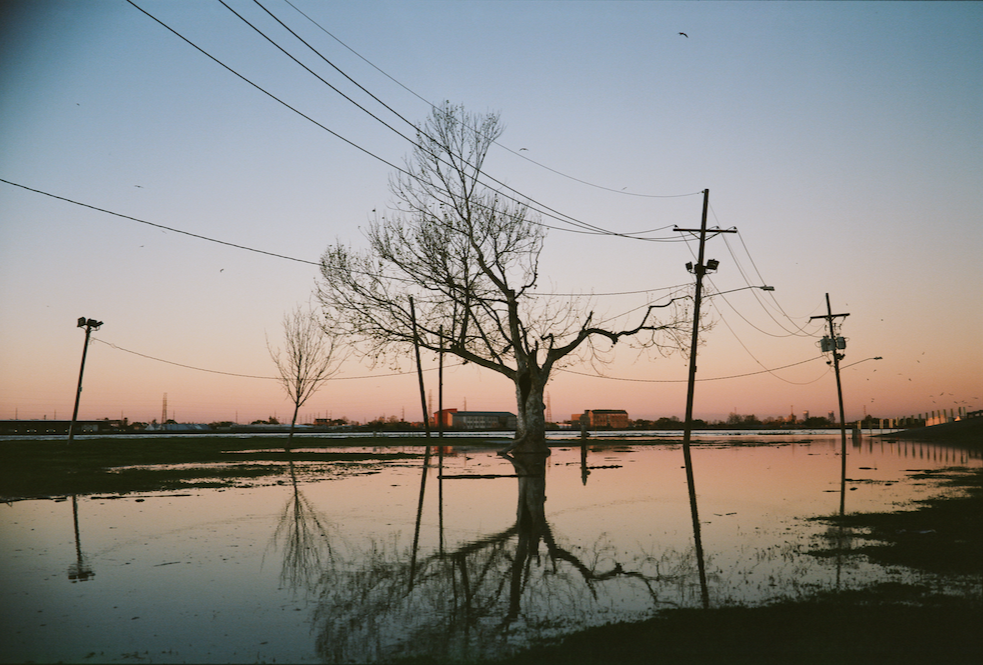Fall/Winter 2025
Ark Building in the Age of Climate Change
By Heather McTeer Toney
Orleans Ave, Tremé, New Orleans. A young family waits, parked on the neutral ground, in anticipation of an oncoming second line, a community oriented jazz parade organized by one of the many Social Aid and Pleasure Clubs in the city. Photography by Brandon Holland.
In July 2025, flash floods swept through Central Texas. Fueled by tropical moisture from the remnants of Tropical Storm Barry, the Guadalupe River rose more than 20 feet in under an hour while local agencies struggled to issue evacuation orders in time. At least 135 people died, making this disaster one of the deadliest inland floods in decades. My heart broke first for those experiencing the unspeakable loss of this disaster, and again when I thought back on my personal memories of the storms and floods that have impacted countless vulnerable people for generations.
Take a drive through the Gulf South and you can’t help but talk to someone with a story about flooding that sounds almost biblical. As a former Mississippi mayor, the former regional administrator for the EPA in the Southeast, and, now, as the executive director of Beyond Petrochemicals, a campaign to stop petrochemical buildout along the Gulf and across the U.S., I’ve seen firsthand how storms compound the trauma of pollution, poverty, and systemic neglect. I’ve sat with families who couldn’t return to their homes after hurricanes and with elders whose fading memories were traumatized by evacuations later in life. The people closest to the disasters are rarely the ones who caused them, but they are the ones forced to carry the weight.
“The people closest to the disasters are rarely the ones who caused them, but they are the ones forced to carry the weight.”
I grew up in Greenville, Mississippi, a small Delta town on the banks of the Mississippi River. Floodwaters and storm threats were part of our seasons. Rarely did a year pass without pulling on boots and wading into streets filled with water, or walking levees with the Army Corps of Engineers to check how badly the river was seeping underneath the walls meant to protect us. Once, during a fast-moving flood, my best friend Jackie and I were driving to survey the damage when we saw a house surrounded by rising water and a family outside looking terrified. We quickly realized we were the closest thing to a rescue. We steered through the high water, and together we helped a mother and her three children climb in with as many belongings as they could carry. We drove them out just as the water reached the porch steps. It wasn’t an act of heroism, and we didn’t dare seek acknowledgement for the actions.
Like the story of Noah’s Ark, survival of the flood is an act of faith.
For me, faith has never been separate from action but instead is the foundation of it. I grew up in the Black church, where faith meant service, where Scripture walked hand in hand with organizing, and where justice was not just preached but practiced. I was taught to pray as I learned to read, and I learned early that belief without work is dead. That’s why, in everything I do, from public service to climate justice to raising my children, I lead with faith. It shapes how I show up in community, how I interpret urgency, and how I see hope. In Before the Streetlights Come On, I wrote about the spiritual calling to protect God’s creation and each other. One story that sits with me constantly is the story of the Ark. It’s not just a tale of survival to me. It is a blueprint for how we prepare, how we serve, and how we center love and justice in the face of crisis.
“The flood wasn’t a fairy tale or a surprise. It was a forecast, and the only surprise was the difference between those who believed the water was coming and those who didn’t. The Ark wasn’t a miracle. It was a plan.”
Upper Ninth Ward, New Orleans. Along the levee, behind the abandoned Bywater Naval Base lies a stretch of land locally referred to as The End of The World. Pictured is a memorial to a recently passed member of the unhoused community. Photography by Brandon Holland.
Beneath the soft edges taught to children lies a hard, grown-up truth. The flood wasn’t a fairy tale or a surprise. It was a forecast, and the only surprise was the difference between those who believed the water was coming and those who didn’t. The Ark wasn’t a miracle. It was a plan.
We are living in Ark-building times. And we don’t have to look far to see the water rising. Over the last two decades we have experienced 244 natural and climate disasters. That’s more than double the twenty years prior.
Today, the water comes not only from the sky but also from rising seas, failing infrastructure, and policies that still greenlight chemical plants in the very places we are evacuating. The climate crisis is not a distant threat. It is present-tense and personal, especially for people of color, low-income families, and frontline communities who live closest to refineries and petrochemical facilities.
Just last year, Hurricane Beryl tore through East Texas, including Houston. It was the earliest Category 5 hurricane out of the Atlantic ever recorded. More than 40 Texans died, several in the extreme heat after the storm while the power was out. Recovery costs totaled more than $7 billion.
These are storms of biblical proportions. They are fast, deadly, and intensified by climate change. Each one serves as both a disaster and a warning. Along the Gulf Coast, communities know this truth all too well. They understand the fear, risks, and dangers when a storm rolls through their hometown. And too often, just beyond their backyards, a petrochemical plant sits in the path of disaster, turning the same flooding, fires, and winds into a toxic catastrophe.
“The climate crisis is not a distant threat. It is present-tense and personal, especially for people of color, low-income families, and frontline communities who live closest to refineries and petrochemical facilities.”
In Harris County, home to Houston’s massive petrochemical corridor, more than 70 percent of industrial sites are located in flood-prone zones. That includes areas where chemical tanks, wastewater ponds, and hazardous materials are exposed to floodwaters. The same pattern exists across southern Louisiana and the Ohio River Valley. And still, new permits continue to be issued.
Beyond Petrochemicals analyzed Gulf hurricane and tropical storm data over the last ten years to determine just how often specific locations where the petrochemical industry is proposing to grow have been hit by storms. We found that 80 percent of the proposed projects surveyed faced impacts from at least one storm in the last ten years — and 70 percent have been hit more than once. As hurricanes are expected to become more common and more severe, the petrochemical industry is proposing to build in the path of disaster.
If Noah were here today, he would not be waiting for a press conference or a climate summit. He would be gathering and hammering wood. He would be organizing his neighbors and reminding them that the water will come. He would be putting up solar panels and blocking permits for plastic plants in hurricane-prone parishes. He would be building with the clear understanding that faith requires action.
Algiers Point batture, New Orleans. The Mississippi river reaches its peak during spring as snowmelt and spring rains make their way down the watershed. Photography by Brandon Holland.
We need that same urgency now. And we can start by remembering, as adults, some of the lessons from the Ark story that we learned as kids.
1.
Planning is moral leadership.
Noah did not wait for the flood to begin nor did he care that people thought he was crazy. He built in the clear light of day. Resilience demands the same from us. That means speaking out against permits that will continue to harm us, investing in early warning systems, and ensuring our public infrastructure is prepared for major storms that are becoming more frequent.
2.
Equity decides who survives.
The Ark was not a luxury ship. It was a lifeboat designed for all living things. Today, our climate preparations must reflect the same and prioritize communities most impacted by pollution and disaster. Implementation must go beyond metrics and reach real families in places like Port Arthur, St. John the Baptist Parish, and Appalachia.
3.
Stop permitting more pollution.
More than 1,400 toxic chemical facilities across the United States are located in areas with a high risk of flooding, with many concentrated along the Gulf Coast. We cannot claim to build resilience while approving permits for new toxic plants in the same zip codes we are evacuating.
4.
Faith in action means more than prayer.
I believe in prayer. I also believe in budgets, blueprints, and ballot boxes. Faith alone did not keep Noah dry. He followed instructions precisely, did the work, and prepared for what was coming. So must we.
5.
Hope is a verb.
Hope is not passive. It is not blind optimism. It is organizing, mobilizing, and building for the future we want. That future includes children breathing clean air, communities protected from chemical exposure, and neighborhoods built to withstand disaster.
We still have time. But not forever. If we fail to act now, if we continue to expand petrochemicals in places already drowning, we are not just ignoring the storm. We are abandoning the Ark.
There is still room on the boat. But we have to build it together.
Heather McTeer Toney is the executive director of Bloomberg Philanthropies’ Beyond Petrochemicals campaign. During her decades of commitment to public service and environmental justice, she has served as mayor of Greenville, Mississippi, and Regional Administrator for EPA Region 4.
Heather was named a 2025 Forbes Sustainability Leader. Her book, “Before the Streetlights Come On: Black America’s Call to Climate Action,” was published by Broadleaf Books in April 2023.




